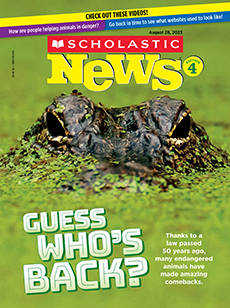Courtesy of family
Ava Simmons uses lemons to make electricity.
Ava Simmons loves to do experiments. She’s created homemade rockets, made her own slime, and even used lemons to make electricity. And she turned her hobby into a successful business.
The seventh-grader from Durham, North Carolina, is the founder of Team Genius Squad. Her company sells kits with the supplies kids need to perform experiments. Ava also has a line of books, puzzles, and other items related to STEM (science, technology, engineering, and math).
“The best part about running my business is seeing the shocked faces of kids when they learn something new,” she says.
Ava Simmons loves to do experiments. She’s created homemade rockets and made her own slime. She’s even used lemons to make electricity. And she turned her hobby into a successful business.
The seventh-grader is from Durham, North Carolina. She is the founder of Team Genius Squad. Her company sells kits with the supplies kids need to perform experiments. Ava also has a line of books, puzzles, and other items related to STEM. STEM refers to science, technology, engineering, and math.
“The best part about running my business is seeing the shocked faces of kids when they learn something new,” she says.

